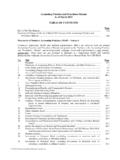Transcription of Accounting for Business Combinations Executive …
1 1A GUIDE TO Accounting FOR Business Combinations 2012 McGladrey & Pullen, LLP. All Rights current guidance on Accounting for Business Combinations , which is captured in Topic 805 of the Codification, has been in effect since 2009. Insights we have gained as a result of the application of this guidance include the following: yThe required use of a fair-value model to account for Business Combinations has increased the involvement of valuation specialists both related to management s Accounting for a Business combination and the auditor s testing of the amounts recognized. yIt is extremely important for the buyer to determine as early in the acquisition process as possible whether it has acquired a Business within the scope of the Business combination Accounting guidance because whether a Business has been acquired or not has significant Accounting and valuation implications.
2 YThe definition of a Business is one of the more challenging aspects of the Business combination Accounting guidance to implement in practice because that definition encompasses much more than just a group of assets or net assets that could function together as a standalone Business . A significant amount of judgment may need to be exercised in determining whether a Business has been acquired. yThe Accounting for contingent consideration (including measuring it at fair value initially, classifying it appropriately as either an asset/liability or equity, and subsequently adjusting it to fair value if classified as an asset/liability) is also one of the more challenging aspects of the Business combination Accounting guidance. These observations and many others underscore the importance of familiarizing yourself with the Business combination Accounting guidance before a Business combination occurs.
3 Doing so will prepare you and allow you to plan for the Accounting challenges that await. This Executive summary provides you with the start you need an overview of the Accounting guidance applicable to Business locate additional information on specific aspects of the Business combination Accounting guidance, refer to the table of contents. In addition, refer to Section for definitions of acronyms and titles for authoritative literature references utilized throughout the guide. ScopeA Business combination occurs when the buyer obtains control of a Business through a transaction or other event. The three key elements in the definition of a Business combination are the following: 1. That which is being acquired must meet the definition of a Business . A Business includes inputs and processes that are at least capable of producing outputs ( , outputs do not have to be part of the transferred set).
4 In some situations, considerable judgment will need to be exercised in determining whether a Business (rather than just a group of assets or net assets) was acquired by the buyer. For Executive SummaryThis Executive Summary is part of McGladrey s A Guide to Accounting for Business Combinations and should be read in conjunction with that GUIDE TO Accounting FOR Business Combinations 2012 McGladrey & Pullen, LLP. All Rights , all of the inputs and processes used by the seller to produce outputs do not have to be acquired to conclude that a Business has been acquired. determining whether sufficient inputs and processes have been acquired in these situations to conclude that a Business has been acquired often requires considerable judgment to be The buyer must obtain control of a Business . The definition of control used for this purpose is the same definition used in determining whether a voting interest entity should be consolidated.
5 The usual condition for control is a greater than 50% ownership interest in the investee ( , a majority ownership interest). However, control may be obtained under other circumstances as well. For example, one entity may obtain control of another entity through contract alone. 3. Control can be obtained by the buyer through a transaction or other event. An other event may occur through no direct action of the buyer. For example, the buyer may obtain control of an investee as a result of that investee acquiring its own shares, which has the effect of increasing the buyer s ownership interest to that of a controlling interest. Assume that an investor owns 60,000 shares in a Business and the Business has 150,000 shares outstanding. In this situation, the investor owns a 40% interest in the Business and accounts for its investment using the equity method.
6 If the Business buys or redeems 50,000 of its own shares from other investors, those shares are retired or become treasury shares and are no longer considered outstanding. As a result, the investor s ownership interest in the Business increases to 60% (the investor s 60,000 shares in the Business divided by 100,000 shares outstanding). This example illustrates that an investor can become a buyer by obtaining control without transferring consideration and without undertaking any other direct action on its own behalf and be subject to the Business combination Accounting guidance. Transactions that meet the definition of a Business combination include: (a) leveraged buyouts, (b) Combinations between two or more mutual entities, and (c) initial consolidation of a VIE when the VIE and PB are not under common control and the VIE is a Business .
7 In addition, depending on the facts and circumstances, the acquisition of a development stage entity could meet the definition of a Business combination. Even if a transaction or other event satisfies the definition of a Business combination, there are specific types of transactions explicitly excluded from the scope of the Business combination Accounting guidance in Topic 805. Examples include Combinations between not-for-profit entities and Combinations between entities under common control. Accounting for mergers and acquisitions of not-for-profit entities is covered in Topic 954-805 and Topic 958-805. Accounting for Combinations between entities under common control is covered in Topic whether a transaction or other event should be accounted for as a Business combination instead of an asset acquisition has significant Accounting repercussions.
8 For example: yGoodwill is recognized in a Business combination, but not in an asset acquisition; yAcquisition costs are generally expensed as incurred and when the related services have been received by the buyer in a Business combination, while the same costs are generally considered part of the cost of the assets (or net assets) in an asset acquisition; and yAssets acquired and liabilities assumed in a Business combination are measured predominantly at fair value, while assets acquired and liabilities assumed in an asset acquisition are measured by allocating the total cost of the net assets based on the fair values of the individual assets acquired and liabilities assumed. These are but a few of the reasons why it is important to draw the appropriate conclusion about whether a Business was GUIDE TO Accounting FOR Business Combinations 2012 McGladrey & Pullen, LLP.
9 All Rights is also important to note that the definition of a Business used for purposes of determining whether a Business combination has occurred is also used in other Accounting determinations. For example, the definition of a Business discussed herein is also used in determining : yThe reporting units for purposes of goodwill impairment testing. Reporting units are the level at which goodwill is tested for impairment and the level at which a goodwill impairment loss is recognized and measured. The definition of a reporting unit relies, in part, on what constitutes one level below an operating segment ( , a component), which relies, in part, on the definition of a Business . yWhether the guidance in Topic 810-10 on how to account for decreases in a parent s ownership interest in a subsidiary (including decreases that result in deconsolidation) applies to a particular transaction.
10 With limited exceptions, the sale ( , deconsolidation) of a subsidiary or group of assets that meets the definition of a Business would be accounted for using this guidance, which would likely result in the recognition of a gain or loss upon deconsolidation. The limited exceptions involve sales of ownership interests that are in-substance real estate or the conveyance of oil and gas mineral rights. yWhether goodwill should be allocated to a portion of a reporting unit that is being disposed of for purposes of determining the gain or loss on disposal. If the portion of a reporting unit being disposed of meets the definition of a Business , goodwill should be allocated to the Business . An entity must consistently apply the definition of a Business in these and other places in GAAP in which it is Accounting modelThe overall Accounting model used to account for a Business combination consists of the following four steps: 1.














